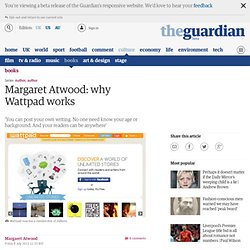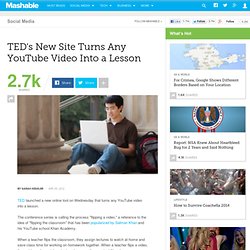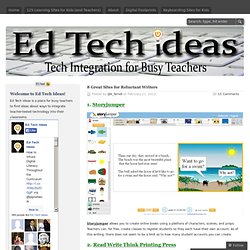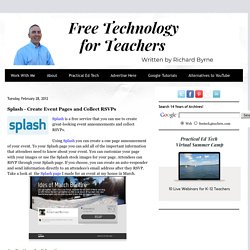

Splash Page. Splash Page. Margaret Atwood: why Wattpad works. Once again people are giving me strange looks.

Why Wattpad? And, indeed, what pad? Wattpad, as in wattage, the kind that makes the lights turn on. "But Margaret," you can hear them whispering. "You're a literary icon at the height of your powers; it says so on your book covers. Maybe my dates with Wattpad are a bit undignified. On www.wattpad.com – using your computer, tablet or phone – you can post your own writing.
Think of the outlets young writers of my generation had at our disposal. Wattpad was started in 2006, before the tsunami of ebooks. We hear a lot these days about two ideas. The second idea is that traditional publishing is doomed. But shouldn't writers get paid for their work? Our generation in the west was lucky: we had readymade gateways. Allen Lau, the co-founder of Wattpad, remembers getting a letter from an old man in a village in Africa.
Playfic - Write and Read Interactive Stories. Video creation that's simply powerful, easy and free. TED's New Site Turns Any YouTube Video Into a Lesson. TED launched a new online tool on Wednesday that turns any YouTube video into a lesson.

The conference series is calling the process "flipping a video," a reference to the idea of "flipping the classroom" that has been popularized by Salman Khan and his YouTube school Khan Academy. When a teacher flips the classroom, they assign lectures to watch at home and save class time for working on homework together. When a teacher flips a video, they add supplemental content such as questions and additional resources. Here's how it works: Users can search YouTube from TED Ed's new website.
When they find a video they'd like to use as a lesson, they hit a "flip it" button. The lesson editor looks like this: The Art of Storytelling - Hear a Story, Tell a Story. WeVideo - Collaborative Online Video Editor in the Cloud. Writing prompts. 8 Great Sites for Reluctant Writers. 8 Great Sites for Reluctant Writers 1.

Storyjumper Storyjumper allows you to create online books using a plethora of characters, scenes, and props. Teachers can, for free, create classes to register students so they each have their own account. As of this writing, there does not seem to be a limit as to how many student accounts you can create. 2. ReadWriteThink creates a lot of great educational resources. 3. Kerpoof is an online story and comic-creator which allows students to create comic scenes and stories, as well as animated movies, cards, drawings, doodles, and pictures. March 2012. My Story - Book Maker for Kids. Splash - Create Event Pages and Collect RSVPs. Splash is a free service that you can use to create great-looking event announcements and collect RSVPs.

New Website Lets You Build Stories Out of Reaction GIFs. Words aren't always enough to express your feelings.

At least, that's according to the makers of That's So True, a site that allows you to convey your emotions with reaction GIFs. Reaction GIFs are short, multi-image animations of people — often TV or movie celebrities — acting out specific emotions. The recent uptick in these GIFs' popularity sparked tech startup Spartz Media to launch That's So True on Thursday. Bio Cube.
The Bio Cube interactive has been changed to a new format: the Cube Creator.

Summarizing information is an important postreading and prewriting activity that helps students synthesize what they have learned. The interactive Cube Creator offers four options: Bio Cube: This option allows students to develop an outline of a person whose biography or autobiography they have just read; it can also be used before students write their own autobiography. Specific prompts ask students to describe a person's significance, background, and personality.
Mystery Cube: Use this option to help your students sort out the clues in their favorite mysteries or develop outlines for their own stories. Story Cube: In this cube option, students can summarize the key elements in a story, including character, setting, conflict, resolution, and theme. #48 Storybird. This week we review the tool, Storybird Storybirds are short, art-inspired stories you make to share, read, and print.

Why we like Storybird: It is free (there are pro upgrades available – see below for info and your chance to win!) It is easy to useTeacher accounts can be created which means students do not need email addresses to sign upChildren under 13 can have their own account (unlike many web 2.0 tools)Student work can be kept private and Storybird takes privacy seriouslyStorybirds can be commented onCompleted Storybirds can be embedded on blogs or websitesIt is suitable for a wide range of ages (especially primary school/junior secondary)It fosters student creativity and collaborationIt is an authentic way for students to practise their writing skills.